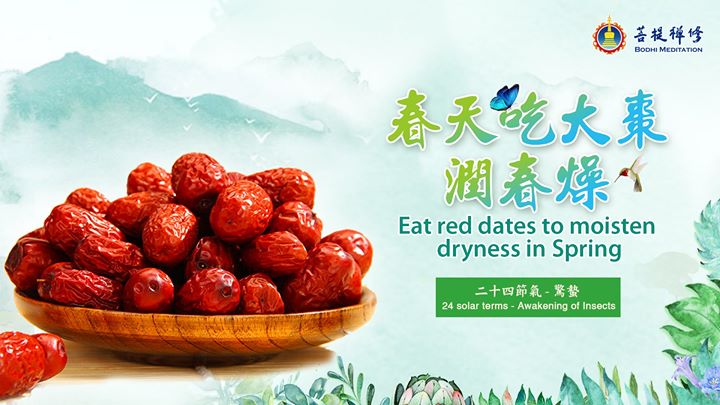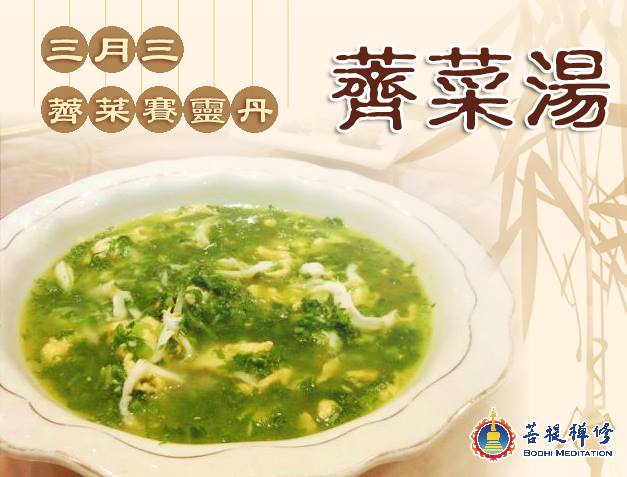【菩提養生素食教室】——菠菜糕
.
今天要料理的「紅嘴綠鸚哥」可不是鳥,而是一道春季家常菜——菠菜,提起這個菜名的由來,還有一段趣聞。
.
據傳在清朝,乾隆皇帝私下江南。一日中午,乾隆行至鎮江南鄉,感到腹中饑餓,便走進路邊一農戶家中,決定借這農戶家歇一會兒腳,找點食物充饑。進了門,只有農婦一人在家。乾隆便向她說明來意。農婦見家中來了一位衣著華麗的官人,又驚又愁:驚的是,這偏僻村莊居然來了貴客;愁的是家中實在貧寒,沒有什麼佳餚好招待貴客。農婦在家中尋來找去,僅有上午男人帶回來的兩塊豆腐。她只好又到田裡拔了一把菠菜,將豆腐切成小塊,用油煎成兩面金黃後,投入菠菜一同燴煮,盛了一大碗,端給客人吃。乾隆生在皇宮,每天吃的是山珍海味,哪裡吃過農家小菜,加上腹中饑餓,更覺口味鮮美。
.
乾隆心想:我雖為一國之君,何時享受過今天這樣口福,但不知此菜是用什麼做的?於是,詢問農婦剛才吃的是什麼山珍海味?農婦見問,暗自好笑,這哪是什麼山珍海味?只不過是一般家常飯菜罷了。豆腐用油一煎,外面金黃色,裡面白玉色,菠菜葉綠根紅,像極鸚鵡的嘴巴。客人既然這樣發問,不妨說一個好聽的菜名告訴他。便隨口回答:「這菜是『金鑲白玉板,紅嘴綠鸚哥』。』至今,在鎮江民間,只要人們一說:「金銀白玉板,紅嘴綠鸚哥。」便知是菠菜豆腐湯了。由於它是素湯,菠菜新鮮、豆腐白嫩、爽口味美,製作簡單,已成為人們喜愛的一種家常菜。
.
隨著現在醫學科學的發展,我們知道,菠菜即便焯水後,還會殘存少量的草酸,與豆腐中的鈣結合,形成人體難以吸引的草酸鈣。因此菠菜儘量少與豆腐同食。所以今天要教大家料理的「紅嘴綠鸚哥」相當特別──菠菜糕。營養又美味,大人小孩都喜愛的口味,材料與作法如下。
.
材料──
1、麵粉100克
2、菠菜250克
3、香蔥、薑末、蒜末、炒熟白芝麻、香油、鹽,各少許
4、鮮味醬油2勺,醋半勺,白糖半勺
.
作法──
1、菠菜切斷,加一勺鹽,使勁搓出水。
2、加麵粉,攪均,中火蒸20分鐘。
3、菠菜糕出鍋後,切成小塊,擺盤。
4、調汁:
①蔥花、蒜末、薑末、芝麻,放在碗中備好;
②鍋中放油,炸花椒和八角;
③花椒、八角扔掉;
④熱油澆在第①步的調料碗中;
⑤加入鮮味醬油、香油、醋、白糖,攪勻。
5、切好的菠菜糕蘸料汁吃。
.
.
感謝網友熱情製作,歡迎大家投稿!
#春季養生、#菠菜、#紅嘴綠鸚哥、#菩提養生素食教室
菜譜來源:https://www.xiangha.com/caipu/92813375.html
.
.
Bodhi vegetarian health food recommendation- Spinach cake
Today, we will prepare “Red mouth green parrot”.
This name sounds like a kind of bird, but it is not. It is actually a home cooked food normally eaten in the spring ie the Spinach. The fanciful name of the dish has an interesting history.
According to legend, during the Qing dynasty, Qianlong emperor privately visited Jiangnan. One afternoon, when Qianlong was at the south village of Zhenjiang, he suddenly felt hungry and entered a peasant’s home with the intention of taking a rest and filling his stomach.
When he entered the hut, only the female peasant was at home. Upon seeing her, Qianlong explained to her the intention of his visit. The lady, seeing such a well dressed court official, felt both surprised and worried. Surprised because a distinguished guest actually had visited her home in this rural and remote village, and troubled because she is very poor and her house did not have any good ingredients for her to whip up a good enough meal to serve the well dressed, distinguished guests.
After rummaging her home, she found only two pieces of bean curd (toufu) which her husband brought back earlier in the morning. At her wit’s end, she went to her fields and brought back some spinach. She sliced the toufu into small cubes and deep-fried them until they turned golden. Using both the fried toufu and spinach, she made a stew. Scooping a generous portion, she offered the cooked stew to her guests.
Qianlong, having born and grown up in the palace, was used to eating all sorts of delicacies every day. In fact, he had never tasted home cooked food from a peasant’s family, which, to him, was something different especially when he was feeling ravenous. He thought that the stew served to him was the best food he had ever tasted!
Qianlong thought to himself: Although I am the king of a country, I had never had the gourmet’s luck of tasting something so good; I wonder how this delicious dish is prepared? Hence, he asked the female peasant what was the delicacy that she had just presented to him. The female peasant, upon hearing Qianlong’s question, felt that Qianlong was rather laughable, as to her, what she had served was just a very normal home cooked meal from a peasant family and not a delicacy. Toufu, after deep-frying, appeared golden on the exterior, while still retaining its white interior. Spinach, with its green leaves and roots slightly reddish, resembled the mouth of a parrot. Since her guests asked her for the name of the “delicacy” which to her is just a normal dish, she came up with an impressive name to answer her guest. This dish is called “Gold plated white jade, red mouth green parrot”. In other words, spinach toufu soup. Since it is a simple vegetarian dish which requires only fresh spinach and soft white toufu and yet taste palatable and easy to prepare, it has since grown to become a popular home cooked food.
With the advancements of medical science, we are all aware that after blanching spinach, there will still be remnants of oxalic acid, which when paired with the calcium from toufu, formed calcium oxalate, which is difficult to be absorbed by our human body. As a result, people seldom eat toufu and spinach together. Hence, we will share with everyone today “red mouth green parrot” dish, an extremely special and unique spinach cake. Nutritious and palatable, it is very popular among people across all age groups. Ingredients and preparation methods are as follows:
Ingredients:
1) 100 g of flour;
2) 250g of spinach;
3) A little onions; powdered ginger; powdered garlic; fried white sesame seeds; sesame oil; pepper, star anise and salt;
4) 2 teaspoons of soy sauce; half teaspoon of vinegar; half teaspoon of white sugar
Preparation method:
1 Sliced spinach, add one teaspoon of salt and rubbed till water appears;
2 Add flour, mix well, steam using medium fire for 20 minutes;
3 After steaming, cut spinach cakes into small pieces and place them on plates to be served;
4 Sauce preparation:-
a Add chopped green onion, powdered ginger, garlic and sesame into a bowl;
b Add oil to a pot and fry pepper and star anise;
c Discard the pepper and star anise after frying. We just want to retain the fragrant oil;
d Add the fragrant oil into the bowl of ingredients prepared in step (a);
e Add soy sauce, sesame oil, vinegar, white sugar and blend well. The sauce is ready to be served;
5 Dip spinach cake to the prepared sauce and enjoy!
.
.
.
#SpringNourishment, #Spinach, #RedMouthGreenParrot, #BodhiVegetarianHealthFood
Source of Recipe: https://www.xiangha.com/caipu/92813375.html
https://www.facebook.com/1656157281338091_1928810044072812



